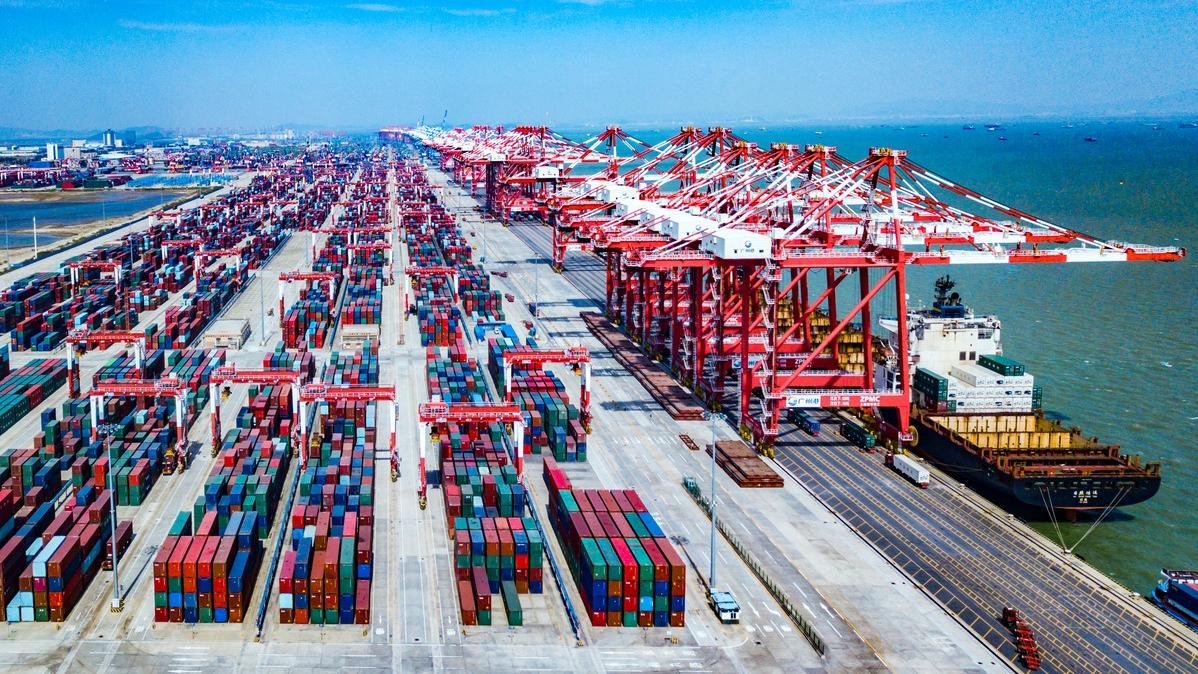 This undated photo shows a view of Nansha Port in Guangzhou, South China's Guangdong province. (PHOTO PROVIDED TO CHINA DAILY)
This undated photo shows a view of Nansha Port in Guangzhou, South China's Guangdong province. (PHOTO PROVIDED TO CHINA DAILY)
NANNING - The rumbling sound and ground vibration from the machines inside a workshop on the outskirt of Nanning, capital of south China's Guangxi Zhuang autonomous region, were palpable even at a distance.
Workers hired by Nanning Paperjoy Paper Industry Co, Ltd were scrambling to step up production as overseas orders have been piling up.
On Friday, 112 tonnes of PE-coated paper rolls manufactured by the company worth 980,000 yuan (about $137,987) became the first batch of goods that set sail from Guangxi for the Philippines to get issued the Certificate of Origin (CO) under the Regional Comprehensive Economic Partnership (RCEP) by local customs authorities.
In 2022, Chinese exporters saw an estimated 1.58 billion yuan in tariff reductions for 235.3 billion yuan worth of goods shipped under RCEP, while the total value of imported goods that enjoyed preferential tariff rates reached 65.3 billion yuan, with cuts in tariffs amounting to 1.55 billion yuan
And with that piece of paper, the tariffs on these goods were expected to be slashed from the original 15 percent to effectively zero.
The RCEP entered into force in the Philippines on Friday, marking a milestone of the world's largest free trade pact being fully effective for all 15 member countries.
"We have, on average, three batches of goods leaving for the Philippines every month. It is a pivotal destination for our export business", said Chen Zhongshu, the marketing director for Southeast Asia of the company, "after the RCEP comes into effect in the country, the Certificate of Origin will grant us over 300,000 yuan in tariff reductions each month, it is a morale booster for us who are in the process of business expansion."
"We see RCEP as a critical key toward inclusive economic growth, not only for the Philippines but within ASEAN," Philippine Trade and Industry Secretary Alfredo Pascual was quoted as saying in earlier report.
ALSO READ: Official: RCEP marks 'milestone' for Philippines
Describing RCEP as "a modern, comprehensive, high-quality and mutually beneficial economic partnership," Pascual said the Philippines had secured enhanced market access for its key products such as preserved pineapples, durian, chocolate, and ignition wiring sets.
The Philippine Senate ratified RCEP this February, completing the process of joining the world's largest free trade agreement.
In 2022, Chinese exporters saw an estimated 1.58 billion yuan in tariff reductions for 235.3 billion yuan worth of goods shipped under RCEP, while the total value of imported goods that enjoyed preferential tariff rates reached 65.3 billion yuan, with cuts in tariffs amounting to 1.55 billion yuan.
The implementation of RCEP plays the role of ballast in attracting foreign investment for China as more and more investors are actively pursuing business opportunities that have arisen and further deepening their existing cooperation.
READ MORE: Experts urge integration at RCEP forum
In 2022, trade between China and other RCEP members increased 7.5 percent year-on-year to 12.95 trillion yuan, and RCEP investment in China, in actual use, climbed 23.1 percent to $23.53 billion, data shows.
"Australia welcomes the role RCEP is playing in bolstering trade architecture across our region", said Anthony Aspen, Australian Consul-General in Guangzhou, recently at an RCEP trade and investment exchange fair where 11 trade and cooperation project deals worth a total of 10.3 billion yuan were inked between Chinese and Australian companies.
Praising the agreement for delivering a range of improvements in areas with significant growth potential, Aspen added that "RCEP locks in market access and addresses non-tariff barriers to trade, creating significant new trade and investment opportunities across our region."
Signed in November 2020, the landmark RCEP agreement covers roughly 30 percent of the world's gross domestic product and population. It entered into force on Jan 1, 2022, with the aim of gradually eliminating tariffs on over 90 percent of goods traded among its members.


